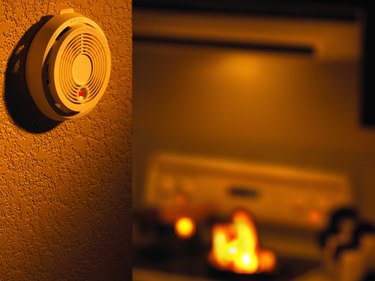
Many homes in the U.S. have a fire alarm system installed, but not all homes have one that's working. The reason an alarm fails to work can be as simple as a dead battery or a wire that's frayed or disconnected. Fortunately, two-wire and four-wire systems are not difficult to install, operate and monitor.
Two-Wire
Video of the Day
Two-wire fire and smoke alarm units are powered from the circuitry on the control panel. The two wires on the end power the system and trigger the alarm. You must make sure that your control panel is compatible to work with a 2-wire system before installing it. When the system detects smoke, it sends an electrical short to the circuitry panel. The short then triggers the system to sound an alarm.
Video of the Day
Four-Wire
Four-wire alarm systems use different wires for power and triggering the alarm. Two of the four wires generate the power for the smoke alarm, and other two wires are directly connected to the alarm component. As a result, a 4-wire system can self-activate itself because the alarm wires are separate. The wires for the alarm have a separate end-of-line relay that triggers the alarm to activate.
Similarities
There are two basic types of fire and smoke detectors -- photoelectric and ionization, and either type can be used with a two or four-wire detector. Photoelectric systems use light to detect smoke. When large amounts of smoke enter the smoke alarm chamber, the photoelectric sensor detects the abnormality and triggers the alarm. Ionization detectors have a chamber with small amounts of radioactive material to detect smoke. When the radioactive materials detect an imbalance in positive and negative electrodes, the smoke alarm is triggered to go off. Two-wire and four-wire systems both depend on a power source, such as batteries or electricity. Batteries trigger the sounding device of a bell alarm and electricity is required to trigger a voice alarm, and/or to connect to a telephone system to call the fire department.
Differences
The key differences between two and four-wire systems are the numbers of wires and how the wiring is connected to the control panel to trigger the alarm. A four-wire system has separate wires, while a two-wire system uses the same wires to power the unit and to trigger the alarm. The type of control panel you have dictates whether you can install a two-wire or four-wire system. You cannot install a two-wire system on a control panel made for a four-wire system, and vice versa.
Considerations
If you decide to use a 4-wire smoke detector, consider installing a separate power monitor on the last wire for the alarm and the last wire for the power. The power monitor wire will essentially operate as a relay and troubleshooting device to insure that the alarm and power wires are receiving power at all times. If something goes wrong with the system and there is no fire, the faulty wire will set off the alarm, alerting you to repair the corresponding wire for either the power or the fire alarm.
- National Fire Protection Association: Smoke Alarm Safety Tips
- Fire Department New York: Smoke Alarm Guide
- Wire It Yourself: Do It Yourself Home Security and Fire Systems
- Smart Home USA: System Sensor 4-Wire, Photoelectric
- National Fire Protection Association: Smoke Alarms
- AlarmTech: How Smoke Detectors Work
- AlarmSystemStore.com: System Sensor 4W-B Four Wire Smoke Detector